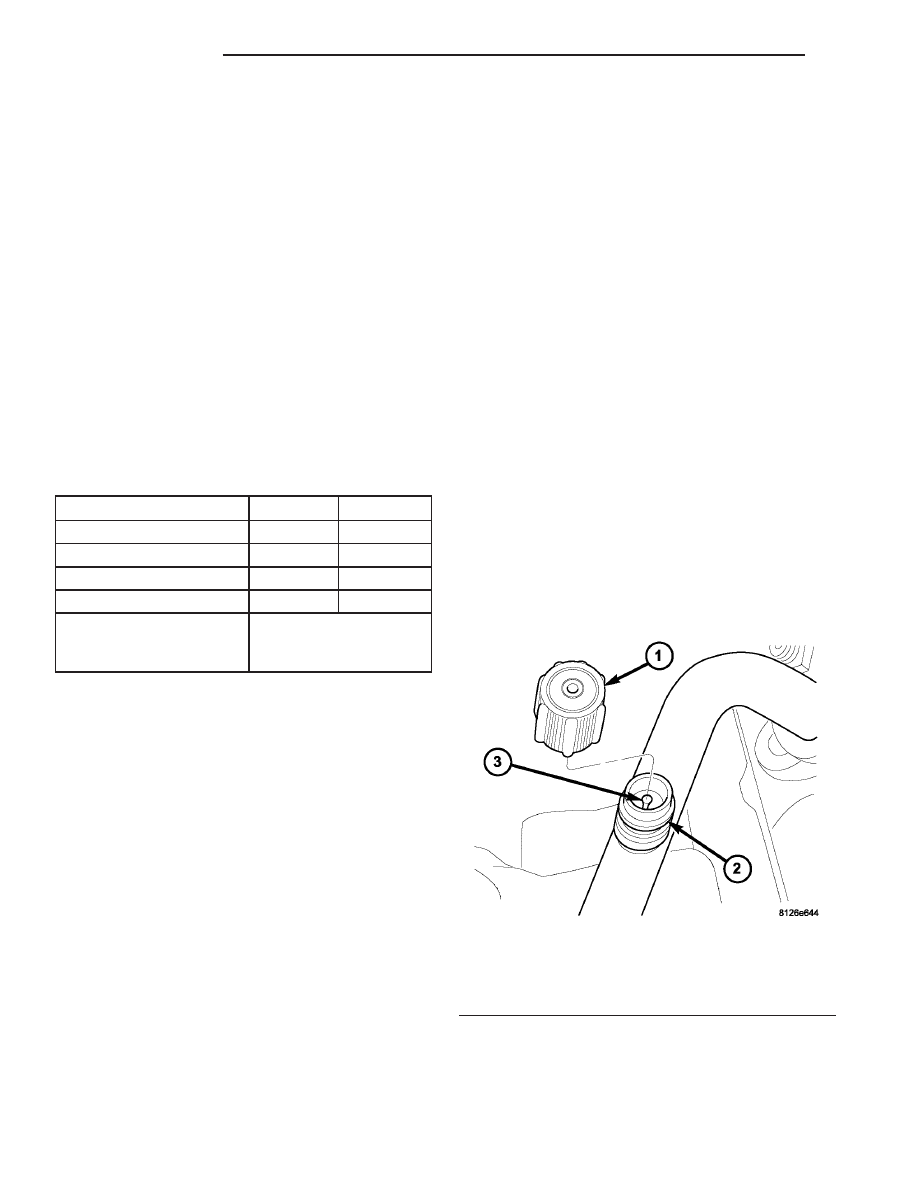Jeep Wrangler TJ. Manual - part 604

It will not be necessary to check the oil level in the
A/C compressor or to add oil, unless there has been
an oil loss. An oil loss may occur due to a rupture or
leak from a refrigerant line, a connector fitting, a
component, or a component seal. If a leak occurs, add
30 milliliters (1 fluid ounce) of refrigerant oil to the
refrigerant system after the repair has been made.
Refrigerant oil loss will be evident at the leak point
by the presence of a wet, shiny surface around the
leak.
Refrigerant oil must be added when an accumula-
tor, A/C evaporator or A/C condenser is replaced. See
the Refrigerant Oil Capacities chart. When an A/C
compressor is replaced, the refrigerant oil must be
drained from the old compressor and measured.
Drain all of the refrigerant oil from the new A/C com-
pressor, then fill the new compressor with the same
amount of refrigerant oil that was drained out of the
old compressor.
REFRIGERANT OIL CAPACITIES
Component
ml
oz
Total System Fill
180
6.1
Accumulator
90
3.0
A/C Condenser
22
0.75
A/C Evaporator
45
1.5
A/C Compressor
Drain and measure the
oil from the old
compressor - see text.
SERVICE PORT VALVE CORE
DESCRIPTION
The A/C service port valve cores are serviceable
items. The high side valve is located on the located
on the manifold directly over the discharge port of
the A/C compressor. The low side valve is located on
the liquid line near the evaporator inlet tube at the
rear of the engine compartment.
Refrigerant system service ports are used to
recover, recycle, evacuate, charge and test the A/C
refrigerant system. Unique sizes are used on the two
service ports for the R-134a refrigerant system to
ensure the system is not accidentally contaminated
with R-12 refrigerant or by service equipment used
for R-12 refrigerant.
The high-side service port is located on the A/C dis-
charge. The low-side service port is located on the
A/C liquid line. Both the high-side and low-side A/C
service port valve cores are serviceable.
NOTE: The protective cap aids in service port seal-
ing and helps protects the refrigerant system from
contamination. Remember to always reinstall the
protective cap onto the service port when refriger-
ant system service is complete.
Each of the service ports has a threaded plastic
protective cap installed over it from the factory. The
service port caps are serviceable items.
REMOVAL
WARNING: Refer to the applicable warnings and
cautions for this system before performing the fol-
lowing operation (Refer to 24 - HEATING & AIR
CONDITIONING/PLUMBING - WARNINGS) and (Refer
to 24 - HEATING & AIR CONDITIONING/PLUMBING -
CAUTIONS). Failure to follow the warnings and cau-
tions could result in possible personal injury or
death.
(1) Remove the protective cap from the service port
(Fig. 23).
(2) Recover the refrigerant from the refrigerant
system (Refer to 24 - HEATING & AIR CONDITION-
ING/PLUMBING
-
STANDARD
PROCEDURE
-
REFRIGERANT SYSTEM RECOVERY).
(3) Using a Schrader-type valve core tool, remove
the valve core from the service port.
(4) Install a plug in or tape over the opened ser-
vice port(s).
INSTALLATION
(1) Lubricate the valve core with clean refrigerant
oil prior to installation. Use only refrigerant oil of the
type recommended for the A/C compressor in the
vehicle.
Fig. 23 A/C Service Port-Typical
1 - PROTECTIVE CAP
2 - SERVICE PORT
3 - VALVE CORE
24 - 82
PLUMBING
TJ
REFRIGERANT OIL (Continued)